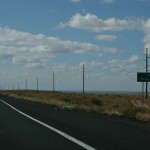 Ah, the weather. Everybody talks about it, but nobody ever does anything about it.
Ah, the weather. Everybody talks about it, but nobody ever does anything about it.
That old joke has a bitter edge for truckers crossing I-40 during Northern Arizona’s windy season. Though the area has always been prone to spring and fall winds, it is only over the last two years that authorities have had to close I-40 in the interest of public safety because of wind and blowing, choking dust.
In 2008, wind and dust-related closures were confined to I-10. But from March to June 2009, authorities closed I-40 five times and required DPS escorts four times, according to Arizona Department of Transportation spokesperson Mackenzie Nuno. Between March of this year and press time, the number climbed to 15 closures; twice when traffic escorts were deployed in windstorms that later led to closures.
When that happens, trucks stack up in parking lots in Winslow, Flagstaff and some- times even Holbrook. That, says Arizona Trucking Association President Karen Rassmussen, sets off a chain reaction that causes freight problems nationwide.
“I-40 carries more truck traffic across Arizona than I-10,” she said. “Truckers using I-10 have alternatives if dust closes the road. Not so for I-40.
“There really aren’t good options. Even for freight that originates in Arizona, most of it is going to Los Angeles – it’s the largest consuming market in the country,” Rassmussen said. So as soon as officials decide to close the road, her organization springs into action. “There are 10 or 12 national organizations and when this happens, we notify them and they get the word out. The most important thing that we can do is make sure the motor carriers nationwide know as soon as pos- sible. That way they can seek an alternate route.”
One small measure of relief is on the way: ADOT says it will have the Meteor Crater rest stop, along with four others around the state, reopened some time in July. (See sidebar.) Those stops were closed and will be reopened for budgetary reasons unrelated to weather.
Authorities agree there is little else anyone can do to combat the problem, at least until someone figures out how serious it is.
Margaret Hiza, a geologist with the U.S. Geological Survey in Flagstaff, hopes to find out what has changed to cause the dust-ups.
“It’s blowing out from the Little Colorado River Valley, but also some other areas in Northeastern Arizona, northward into Colorado and Utah,” she said. “Papers published as early as 1912 describe the dust transport from here into Colorado. But back then, there were not the same technological tools we have now.”
In fact, the USGS has satellite images of dust blowing across the area from some of the storms over the last couple of years.
“There’s a lot of surface deposits here that are vulnerable to erosion because they are very fine-grained. It’s a place that is very sensitive to fluctuations in the amount of wind and the amount of moisture we get,” she said. In fact, the sensitivity of the landscape is part of what lured Hiza here.
“I study the geologic evolution of the Little Colorado River Valley, and what makes it more prone to wind erosion. But I’m also monitoring the area for changes like these,” she said.
The changes could signal a long-term change in the regional climate, or they could just be the result of anomalies. The only way to distinguish is to watch the frequency, duration and severity of wind events.
“We’ve had a lot of weather instability this year and last year…it’s not typical of the climate we live in,” Hiza said. “If next year and the next five or six years there are no high wind events and we don’t get a lot of dust blowing, then I would say it’s just a bilp on the screen. If we have these kinds of wind events every year over the next 10 or 15 years, then it could signal a change in the regional climate.”
The dust that has been vexing motorists and authorities is fine silt blowing up from the Little Colorado River Valley. In a wet year, or even season, the river rises and dumps silt on the banks. Then, when it recedes, the silt – fine particles that carry plant nutrients – blows away.
If a trend emerges over several years, measures such as creating parks or restoring areas of the Little Colorado River watershed might be considered to help bring the dust down.
Meanwhile, it’s impossible to quantify the cost of trucks being sidelined for a wind- or dust-related road closures, Rassmussen says, because there are just too many variables. But the impact shows up in many ways.
Truckers eastbound on the highway are bound for Los Angeles terminals and ports, where they may be booked to pick up return loads or empty containers that need to return to their eastern points of origin.
“It [delivery] is a window. If that truck doesn’t arrive during that window, they can refuse the cargo, or they can say ‘sor- ry, you have to wait until tomorrow,’” she said. “It creates a ripple effect throughout the supply chain.”
Considering traffic volume, it’s mind- boggling that 60 miles of road can throw such a wrench into national commerce. But based on 2008 figures, “data shows average daily traffic at 14,500 vehicles at Twin Arrows Traffic Interchange, the eastbound closure location. There are days when nearly half the overall traffic on I-40 is commercial trucks,” Nuno said. “It is the interstate with the highest average percentage of truck traffic in the state of Arizona.” FBN
To see a satellite image one of the dust storms that forced the interstate closure, visit http://sgst.wr.usgs.gov/dust_monitor- ing/dust-events/may-11th-2010/





